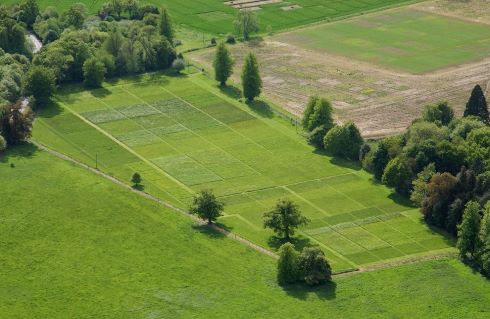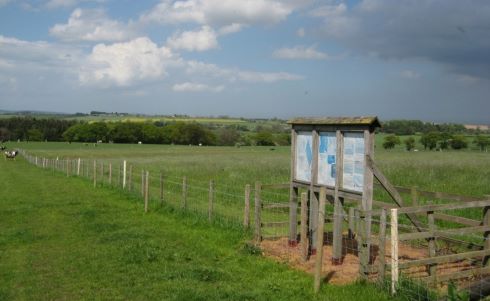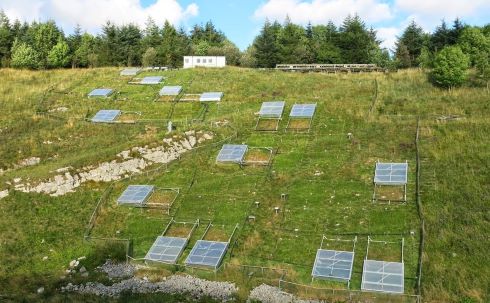In it for the long run

Above: An image of the world-famous Park Grass long-term experiment, courtesy of Rothamstead Research.
Ben Sykes explains how the UK’s long-term ecological field experiments – some of which have been running for over a century – can tell us things that no other studies can
20th February 2023
Can you imagine setting up an experiment that would outlive your career, be taken up by numerous successors and still be running 167 years after you set it up, long after you are dead? Not only that, can you imagine establishing such an experiment not in the laboratory, but out in the ‘real world’? That is exactly what Sir John Lawes and Sir Henry Gilbert did in 1856 when they set up the now-famous Park Grass long-term experiment (LTE) at Rothamsted Research in Hertfordshire.
Little did they know that Park Grass would come to be the longest-running grassland experiment on the planet – and indeed one of the longest-running experiments anywhere in modern science.
Originally established to examine the effect of inorganic fertilisers on grassland yield compared with organic manures, it quickly became obvious that the different treatments were having significant effects on species composition. The experiment has therefore become an ecological study of how fertilisation impacts grassland biodiversity, leading to numerous practical outcomes over the decades. These include helping our understanding of how liming acidified grassland can benefit biodiversity and the site’s use as a ‘proving ground’ for the impacts of policies to reduce acid rain.
LTEs are defined as experiments that have been running in real-world settings for many years. Park Grass is one of two LTEs in the UK that have been running continuously for over a century, the other being Palace Leas in Northumberland. There are scores of others, many of which have been running for 40 years or more. These are ‘true experiments’, manipulating environmental variables in a controlled and – with the development of statistics – replicated manner. Some simulate climate change, while others manipulate a wide range of land management approaches (grazing, for example). However, all of them collectively contribute to evidence-based policymaking around sustainable land management and biodiversity improvement.
To help demonstrate the value and impact of LTEs it is perhaps topical to focus on those that are looking at climate change effects. The Ecological Continuity Trust (ECT) includes within its current network of active LTEs five studies that set out from their beginnings to investigate the impacts of simulated climate change treatments on varying habitats and their ecosystem services. They are located in habitats ranging from upland heath and raised bog to deciduous woodland and upland/lowland calcareous grassland. All are at different stages of their life cycle, with the longest now running continuously for 29 years and the most recent having started in 2017.
 The Palace Leas meadow hay plots at Cockle Park Experimental Farm have been studied for more than a century.
The Palace Leas meadow hay plots at Cockle Park Experimental Farm have been studied for more than a century. BCCIL UPLAND GRASSLAND
The Buxton Climate Change Impacts Laboratory (BCCIL) was established in 1993 on privately owned upland calcareous grassland near Buxton in Derbyshire. It is the longest-running climate change manipulation experiment in the UK and was the brainchild of the late Phil Grime of the University of Sheffield, who managed the site for most of its history. The experiment is now managed by a trio of staff from the universities of Liverpool, Sheffield and Lancaster.
The experiment applies three main climate manipulations, either alone or in combination with one another – winter soil warming, controlled summer drought and supplemented summer rainfall, with a simulated sheep-grazing treatment each year in the autumn. In the first 15 years, research at the site focused on the impacts of the climate treatments on the plant community only and revealed a short-term resistance to change, with only gradual shifts in species abundance that were brought about by the functional ecology of the component species.
 A view over the Buxton Climate Change Impacts Laboratory in Buxton, Derbyshire. The site has been running since 1993.
A view over the Buxton Climate Change Impacts Laboratory in Buxton, Derbyshire. The site has been running since 1993.Subsequently, investigations were added to address population-level adaptive and evolutionary responses within plants and within the soil microbial community, together with impacts on ecosystem process rates. Molecular fingerprinting of soil bacterial and fungal communities has shown marked shifts in these communities under chronic summer drought treatment. These changes are related to plant traits that represent the quality of resource available to soil microbes, such as leaf dry matter content, foliar carbon-to-nitrogen ratios and the construction cost of leaf tissue[1].
This provides good evidence that climate change could affect soil microbial communities indirectly through altered plant inputs.
www.ecologicalcontinuitytrust.org/bccil
BIFOR-FACE – MATURE OAK WOODLAND
The Birmingham Institute of Forest Research (BIFoR) Free-Air Carbon Enrichment (FACE) facility experiment was established in 2017 in privately owned mature oak woodland in Norbury, Staffordshire. It is initially planned to run for 10 years of continuous treatment to 2027, and is one of the most awe-inspiring and ambitious LTEs anywhere in the world, with a sister site in Australia. The research is led by Rob MacKenzie at the University of Birmingham and aims to provide a step-change in our understanding of how mature northern temperate forest will respond to future increases in atmospheric CO₂.
Using large metal structures placed around the trees, the experiment elevates CO₂ to 550 parts per million (approximately 150ppm above current ambient concentration) in small plots of 160-year-old, 25m-tall oak trees mixed with sycamore, hazel, hawthorn and holly. The whole canopy within each plot is infused with enriched CO₂ 24 hours a day, seven days a week, throughout each annual growing season. A wide variety of research projects are under way at the site, including studies on soil fungal communities, fine root growth, soil moisture dynamics, canopy insects, xylem sap flow and microbiomes in the oak tree phyllosphere.
Early results have demonstrated species-dependent increased carbon assimilation, increased fine root production, and prompt responses related to water and nutrient cycling. For readers interested in the engineering aspects and the reliability of the CO₂ inputs, a key paper to read is Hart et al (2019)[2].
www.ecologicalcontinuitytrust.org/bifor-face
CORS FOCHNO – RAISED BOG
Cors Fochno LTE is located on pristine lowland raised bog habitat north of Aberystwyth in mid-Wales. Owned and managed by Natural Resources Wales, this is a rare and vulnerable habitat – one of the most intact raised bogs throughout England and Wales put together. Started in 2010 by the late Richard Payne from the University of York, Cors Fochno investigates peatland responses to climate change, focusing on the combined effects of drought and warming.
While peat only covers 2–3% of global land surface, climate change impacts on peat bogs are disproportionately important - as much as 6% of global carbon is locked up in living and dead Sphagnum mosses. It has been suggested, for example, that should they dry out and be allowed to remain so, raised bogs may ‘flip’ from being net carbon sinks to net carbon sources, which then accelerate climate change[3].
The experiment applies crossed treatments of warming using open-top chambers and intermittent groundwater pumping to small, hydrologically isolated plots. Early results revealed little change in vegetation, but now, under warming treatment, white beak sedge is encroaching at the expense of Sphagnum. This may be important because Sphagnum mosses are much better than vascular plants at forming peat and locking away carbon. The warming treatments appear to be reducing methane emissions, but increasing CO₂ emissions. These slow-developing impacts stress the importance of long-term research and how misleading short-term results can sometimes be.
www.ecologicalcontinuitytrust.org/cors-fochno
CLOCAENOG – UPLAND HEATHLAND
The Clocaenog LTE was established in 1998 on upland heath within Clocaenog Forest in north Wales. It is the second-longest-running climate change LTE in the UK. The site uses simulated drought and warming treatments to test the effects of predicted climate change over the next 20 to 30 years on upland heathland ecosystems. The experiment is managed by Sabine Reinsch from the UK Centre for Ecology and Hydrology in Bangor.
 The Clocaenog LTE in north Wales began in 1998 and is now managed by Sabine Reinsch (pictured)
The Clocaenog LTE in north Wales began in 1998 and is now managed by Sabine Reinsch (pictured)The experiment uses solar and wind-powered automated roof technology to apply drought and warming treatments, situated alongside procedural controls. Over the 20-plus years of the experiment so far, only slight changes in the plant community structure have been observed. More significant changes have taken place below ground – for example, in soil hydrology and respiration. While such changes appear to be weakly linked with the smaller changes in above-ground plant communities, they may well be linked to more noticeable shifts in soil bacterial and fungal communities.
Comparisons of soil community composition from two time points in the experiment – four and 18 years after establishment – show that the climate treatments appear to be altering both soil microbial community diversity and composition throughout the course of the experiment. The findings suggest that above- and below-ground carbon fluxes can decouple, and provide no strong evidence of acclimation to environmental change even at a timescale of decades, with below-ground processes appearing to be more sensitive to environmental change[4].
www.ecologicalcontinuitytrust.org/clocaenog-1
RAINDROP – LOWLAND GRASSLAND
The RainDrop experiment was set up in 2015 on lowland calcareous grassland adjacent to Wytham Woods in Oxfordshire. The experiment applies two climate change scenarios – drought conditions (50% below ambient rainfall) and enhanced rainfall conditions (50% above ambient rainfall) to species-rich grassland. The site is managed by Andy Hector from the University of Oxford in collaboration with staff from the Open University.
It is early days yet for clear results and impacts from RainDrop, although so far within-year changes in biomass of the three main functional groups (grasses, legumes and non-leguminous herbaceous species) are largely meeting expectations of reduced productivity under drought conditions. One particularly exciting development at the LTE is the trialling of drones and ground robotic technology to collect multispectral images and infrared data on species abundance and composition at the plots.
www.ecologicalcontinuitytrust.org/raindrop
Long term gains
LTEs are vitally important for two general reasons. First, there is no substitute for real-world experimental evidence; second, short-term results cannot be extrapolated to long-term trends. Long-term datasets have shown that annual changes, or even apparent ‘trends’ of up to three years’ duration, can be noise in the data. In other words, short-term changes may align with, or be completely at odds with, the true long-term trend.
Only when an LTE has run its course on decadal timescales do we genuinely attain an understanding of what is really going on, which has enormous implications for rational, evidence-based policymaking. LTEs are also important for a more specific reason. Their very longevity enables us to use them to address ecological drivers that may change along with the policy landscape, presenting new questions that offer the opportunity to repurpose an LTE and further enrich its dataset.
The ECT is a unique UK-wide charity dedicated to preserving and maintaining LTEs (see ‘About the ECT’, below). As a champion of LTEs and long-term monitoring (LTM), the ECT helps to mitigate some of the significant challenges that these experiments face over decadal timescales – from loss of funding and staff succession issues to the threat of changing landowners and a general lack of recognition and profile.
By donating to the ECT you can help to ensure that the nation’s LTE and LTM resource continues to produce valuable evidence and data that can be used for ecological action. In turn this can help society adapt to environmental change.
Established in 2008, the Ecological Continuity Trust (ECT) is dedicated to preserving and maintaining LTEs and LTM so future generations have the resources needed to manage ecosystems sustainably in the face of environmental change. The charity maintains a national register of over 70 LTEs of which around 40 are currently active across all four countries of the UK, providing small grants and other services to ensure their continuity. It also maintains a network of stakeholders that advocate for LTEs and LTM and the science they produce, and communicates their findings to policymakers and the wider public. For more information visit www.ecologicalcontinuitytrust.org
Ben Sykes MRSB is the executive director of the Ecological Continuity Trust, a Member Organisation of the RSB.
References
1) Sayer, E. J. et al. Links between soil microbial communities and plant traits in a species-rich grassland under long-term climate change. Ecol. Evol. 7(3), 855–862 (2017).
2) Hart, K.M. et al. Characteristics of free air carbon dioxide enrichment of a northern temperate mature forest. Glob. Chang. Biol. 26(2), 1023–1037 (2019).
3) Swindles, G.T. et al. Widespread drying of European peatlands in recent centuries. Nat. Geosci. 12, 922–928 (2019).
4) Reinsch, S. et al. Shrubland primary production and soil respiration diverge along European climate gradient. Sci. Rep. 7, 43952 (2017).


